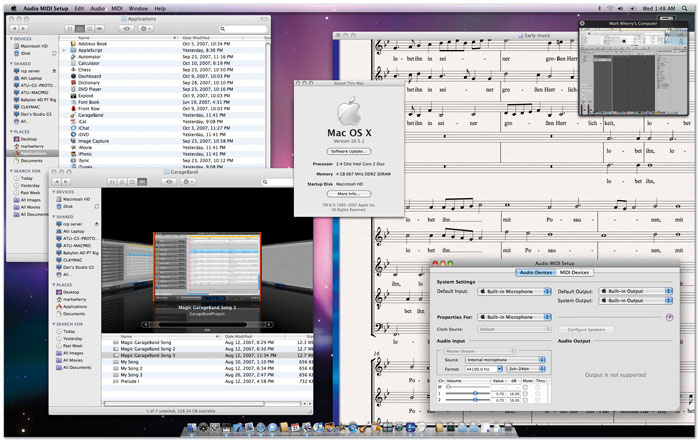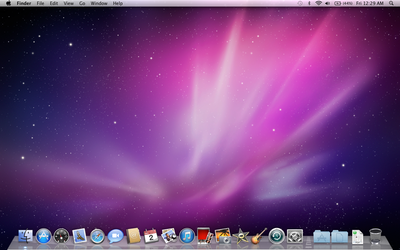The Mojave update
Mac Os X 10.5 Leopard Ppc Download
Mac is a popular OS that keeps coming up with new updates to improve the user experience. Mojave is the newest update.
The latest benefits of the Mac OS
You will get some handy benefits free of charge. Besides the obvious advantages, there are covert improvements that will boost your Mac.
- Os 10.5.8 Leopard free download - Movist for OS X Leopard, Apple Mac OS X Lion 10.7.5 Supplemental Update, Apple Mac OS Update 8.6, and many more programs.
- Mac OS X 10.5 Leopard was released on October 26, 2007 after a lengthy development cycle that Apple said was slowed by the release of the original iPhone. When it did ship, Leopard was a major push forward for OS X. Gone were the numerous window styles that had cropped up in the Panther and Tiger years.
If you’re a user of Mac OS, upgrading to the Mojave version is the logical next step. The only thing you should worry about is to update your apps, as the old versions won’t work on Mojave.
The most significant changes in the newest version relate to aesthetics. With Mojave, you can mute the colors of the interface, so you don’t find yourself blinded when working at night thanks to the Dark Mode. Furthermore, the Dynamic Desktop feature changes the image on your desktop to match the time of the day.
As an operating system, Mac OS has always tried to make things sleek and minimalist on your desktop. However, in the older versions, the sync between Mac and iPhone led to a lot of clutter. To counter that, Apple added Desktop Stacks to make your desktop organized according to the criteria you desire.
Once your older Mac OS X CD or DVD is in your hand, set aside some time with Disk Utility and some blank CD-Rs, DVD-Rs, or, in the case of the Mac OS X 10.5 Leopard and Mac OS X 10.6 Snow Leopard.
These, and many more features allow Mac users to enjoy an even sleeker operating system. Another thing that draws attention is an improvement in Continuity - the connection between the phone and the computer. In general, the newest version of the operating system brings everything the users loved in the previous versions - only enhanced.
Is there a better alternative?
No. Unless you rely too heavily on old apps without new updates, Mojave is a logical extension of your current user experience.
Where can you run this program?
Mac Os X 10.5 Leopard
Mac Mojave runs on Mac computers featuring an OS X 10.8 and later versions.
Our take

This new update took the best features and improved them. There are no obvious drawbacks, Mojave does its job, and it does it properly.
Should you download it?
Yes. If you're a Mac lover, you'll probably want to get OS X Mojave.
Highs
- Dark Mode
- Document Stacks
- New screenshot functionalities
- Increased connection between phone and desktop
Mac Os X 10.5 Leopard Install Dvd
Lows
- Not all apps support this update
- Some iCloud issues
- Can seem a bit slow at times
Mac OS X 10.5.6for Mac
10.5.6
Mac OS X 10.5 Leopard, released on October 26, 2007, was the biggest change to Mac OS X since Apple first released OS X 10.0 in March 2001. For the first time, a version of OS X was certified as Unix, and the new unified appearance makes Leopard friendlier and less confusing for users.
Leopard itself was also a unified operating system. Where Mac OS X 10.4 Tiger had come in separate versions for PowerPC and Intel Macs, the Leopard installer could run on both platforms, and the version of Mac OS X installed could boot either type of hardware. New features included Time Machine automated backup, Stacks, and Cover Flow.
But with every big step forward in features and performance, the Mac OS leaves some older Macs behind. The number of Macs that had been supported by Tiger and left behind by Leoaprd was the biggest for any release of OS X to date: No G3 models were supported, and the installer would not run G4 Macs slower than 867 MHz, although a few workarounds were discovered to address that.
Leopard is immune to the “goto fail” bug identified in early 2014.
After 22 months as the current version of OS X (only Tiger lasted longer, at 30 months), Leopard was succeeded by 10.6 Snow Leopard on August 28, 2009, the first version of OS X to leave all PowerPC Macs behind.
- Leopard Forum, our online group for OS X 10.5 users.
- Leopard List, our email group for Mac OS X 10.5 users.
- Unsupported Leopard Installation, 2007.10.31. How to install Mac OS X 10.5 on unsupported hardware – plus field reports.
- Faking Out the Leopard Installer with Open Firmware, Dylan McDermond, 2007.12.06. You don’t have to hack the installer to make the Mac OS X 10.5 installer run on sub-867 MHz G4 Macs by using this simple Open Firmware trick.


Last Compatible Software
These are the last versions of software compatible with OS X 10.5 Leopard.

From Apple
From Other Vendors
- Adobe Flash Player
- PowerPC: 10.1.102.64
- Intel: 10.3.183.1
Leopard Links
- Why Spaces Is My Favorite Leopard (and Snow Leopard) Feature, Charles W Moore, Miscellaneous Ramblings, 2009.11.23. Spaces, a feature introduced with OS X 10.5, is like having several monitors on your Mac without the cost and space of using multiple displays.
- The Leopard Experience at 867 MHz, Simon Royal, Tech Spectrum, 2008.12.02. Mac OS X 10.5 requires an 867 MHz G4 with 512 MB of memory, but is performance really acceptable on a minimum spec system?
- Does Constant Time Machine Activity Compromise Disk Longevity?, Charles W Moore, Miscellaneous Ramblings, 2008.09.15. Time Machine is a marquee feature of Mac OS X 10.5, but isn’t all of that disk activity likely to wear our your drive prematurely?
- SheepShaver Brings Classic Mac OS to Intel Macs and Leopard, Alan Zisman, Mac2Windows, 2008.05.20. Mac OS X 10.5 doesn’t support Classic Mode. Neither does Leopard. But SheepShaver lets you emulate a PowerPC Mac and run the Classic Mac OS.
- Restoring a Crashed Mac with an Install Disc and Time Machine, Alan Zisman, Zis Mac, 2008.02.06. Thanks to Leopard’s Time Machine backup feature, it’s easy to restore your Mac to an earlier setup if you’ve inadvertently deleted essential files.
- Leopard different, a bit buggy, but worth the upgrade, Adam Robert Guha, Apple Archive, 2007.11.02. Leopard on a Power Mac G4 and a MacBook Pro: It runs well on both computers, but each has some odd bugs, and some of the changes are a step backwards.
Downloadable Updates
Standalone Updates let you update to a newer version of Mac OS X from your hard drive instead of using Software Update, which requires an Internet connection. Download the one(s) you need and install them after mounting the disk image and launching the Installer program.
There are two types of Standalone Updates: Individual (or Delta) and Combo.
- Individual Updates update one version of Mac OS X to the next version. For example, the Mac OS X 10.5.4 Update updates Mac OS X 10.5.3 to version 10.5.4. Individual Updates are also known as Delta Updates.
- Combo Updates update the base version of a Mac OS X release to the version specified in the Combo Update, including all intermediate updates. For example, the Mac OS X 10.5.4 Combo Update updates any earlier version of Mac OS X 10.5 to Mac OS X 10.5.4 using a single installer, as opposed to installing the individual Mac OS X 10.5.1, 10.5.2, 10.5.3, and 10.5.4 updates.
Standalone Updates are generally available 24 to 48 hours after the Update is available through Software Update.
If you burn a Standalone Update to CD, its disk image must be copied to your desktop or another location on your Mac OS X startup disk in order to be installed.
This page will be updated as new Standalone Updates become available.
Mac OS X 10.5.1
Mac OS X 10.5.2
Mac OS X 10.5.3
Mac Os X Download
Mac OS X 10.5.4
Mac OS X 10.5.5
Mac OS X 10.5.6
Mac OS X 10.5.7
Mac OS X 10.5.8
Keywords: #osxleopard #macosxleopard
Short link: http://goo.gl/mnwm3f
Mac Os X 10.5 Leopard Wallpaper
searchword: osxleopard




